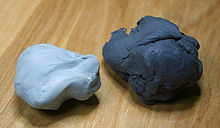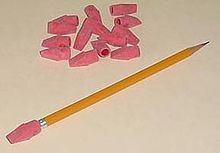- Eraser
-
An eraser (US) or rubber (UK) is an article of stationery that is used for rubbing out pencil markings. Erasers have a rubbery consistency and are often white or pink, although modern materials allow them to be made in any color. Many pencils are equipped with an eraser on one end. Typical erasers are made from synthetic rubber, but more expensive or specialized erasers can also contain vinyl, plastic, or gum-like materials. Other, cheaper erasers can be made out of synthetic soy-based gum.
Contents
History
Prior to the invention of the rubber eraser, tablets of rubber/wax were used to erase lead/charcoal marks from paper. Bits of rough stone such as sandstone or pumice were used by various cultures to remove small errors from parchment or papyrus documents written in ink. Crustless bread was used as an eraser in the past; remembering school days in the College of Engineering in Meiji Tokyo, a student claimed: “Bread erasers were used in place of rubber erasers, and so they would give them to us with no restriction on amount. So we thought nothing of taking these and eating a firm part to at least slightly satisfy our hunger.” [1]
On April 15, 1770, Joseph Priestley described a vegetable gum which had the ability to rub out pencil marks: "I have seen a substance excellently adapted to the purpose of wiping from paper the mark of black lead pencil." He dubbed the substance "rubber".[2][3]
In 1770, Edward Nairne, an English engineer, is credited with developing the first widely-marketed rubber eraser for an inventions competition. He reportedly sold natural rubber erasers for the high price of 3 shillings per half-inch cube. According to Nairne, he inadvertently picked up a piece of rubber instead of breadcrumbs, discovered rubber's erasing properties, and began selling rubber erasers. Incidentally, this was the first practical application of the substance in Europe, and rubbing out the pencil marks gave it its English name.
However, rubber in its raw form shared the same inconveniences as bread, since it was perishable and would go bad over time. In 1839, inventor Charles Goodyear discovered the process of vulcanization, a method that would cure rubber and make it a durable material. Rubber erasers became common with this advent of vulcanization.
On March 30, 1858, Hymen Lipman of Philadelphia, USA, received the first patent for attaching an eraser to the end of a pencil. It was later invalidated because it was determined to be simply a composite of two devices rather than an entirely new product.[4]
Types
Art gum erasers
Another eraser type that is popular with artists is the art gum eraser, made of soft, coarse rubber. It is especially suited to removing large areas, and it does not damage the paper. However, they are not very precise. Gum erasers tend to crumble as they are used, so this type leaves a lot of eraser residue. This "eraser dust" must then be brushed away with care, as the eraser particles can leave marks on the paper. Many artists use a broad brush to sweep away the loose eraser residue. Art gum erasers are commonly tan or brown.
Diener Industries manufactured erasers in the shape of toys. In 1955 Walt Disney contacted William Diener to ask him why souviner pencils sold in Disneyland weren't selling. Diener replied that they were overpriced but he suggested they be sold with erasers in the shape of Disney characters.[5]. His firm manufactured erasers in the shape of characters and animals.
Kneaded erasers
Kneader erasers are a type of eraser common to most artists' standard toolkit. This type has numerous uses. They can be pulled into a point for erasing small areas and tight detail erasing, molded into a textured surface and used like a reverse stamp to give texture, or used in a "blotting" manner to lighten lines or shading without completely erasing them. One weakness of this type is that they can gradually lose their efficacy and resilience as they become increasingly infused with particles they have picked up both from erasing and the environment around them. They are also not very effective at erasing large areas, as they tend to deform under vigorous erasing.
Poster putty
Commonly sold in retail outlets with school supplies and home improvement products, this soft, malleable putty appears in many colors and under numerous brand names. Intended to adhere posters and prints to walls without damaging the underlying paint, poster putty works much the same as traditional kneaded erasers, but with a greater tack or lifting strength. Poster putty does not erase so much as lighten by lifting graphite, charcoal or pastel off a drawing. In this regard, it does not smudge or damage work in progress. Repeatedly touching the putty to a drawing pulls ever more medium free, gradually lightening the work in a controlled fashion. Poster putty can be shaped into fine points or knife edges, making it ideal for very detailed and painstaking work. It can be rolled across a surface to create visual textures. Its ubiquity and affordability makes it all the more attractive. Like traditional kneaded erasers, poster putty also loses its efficacy with use, becoming increasingly tacky as the material grows polluted with debris and oils from the user's skin. Of the many brands available, Blu-Tack has become a favorite of graphite artists around the world.
Electric erasers
The electric eraser consists of a knob in a short thin rod attached to a miniature motor. A button located on one side turns the motor on once pressed, and off when pressure is released from the button. As the knob of eraser turns at a relatively rapid speed, it achieves a smooth and complete area of erasure with a minimum of trauma to the paper. The main purpose this device is designed for is erasing pencil lines or shading completely and precisely in a short time, compared to using a kneaded eraser.
Soft vinyl erasers
Soft vinyl has a plastic-like texture and erases more cleanly than standard pink erasers. They are somewhat softer and non-abrasive, making them less likely to damage canvas or paper. They are prone to cause smearing when erasing large areas or dark marks, so these erasers are more frequently used for erasing light marks and precision erasing. Engineers favor this type of eraser for work on technical drawings due to their gentleness on paper. Vinyl erasers are commonly white.
Ink erasers
A less common type of eraser is used to erase pen. Pulverized pumice is blended into this type of eraser to make it abrasive. However these erasers also remove some layers of the paper so the paper becomes extremely thin and can tear. This eraser is typically a half pen eraser and a half "art gum" eraser. It is used by those who like the look of a pen and the changability of a pencil.
Others
Another type of eraser is used specifically for marks on a chalkboard or whiteboard. Rather than being rubbery or gummy like pencil erasers, it is a hand-held wooden or plastic block with a dark felt pad on one side.
Erasers come in several shapes and sizes. In addition to those that come attached to pencils, they may also be rectangular blocks (block and wedge eraser), or conical caps that can slip onto the end of a pencil (cap eraser). A barrel or click eraser is a device shaped like a pencil, but instead of being filled with pencil lead, its barrel contains a retractable cylinder of eraser material (most commonly soft vinyl). Novelty erasers are made in a wide variety of shapes, colors, and designs to suit their themes (such as musical notes, animals, confectionery), and they are typically acquired more for their decorative nature than for any practical use, as the hard vinyl they are made from tends to smear heavy markings.
See also
References
- ^ [Teiyûkai, Kôbu daigakkô mukashibanashi (Tokyo: Teiyûkai, 1926), 25-26]
- ^ "Joseph Priestley (1733-1804)". http://inventors.about.com/library/inventors/blJosephPriestley.htm. Retrieved 2009-06-30.
- ^ See the footnote on page xv at the end of the preface to the following: Priestley, Joseph (1770). A Familiar Introduction to the Theory and Practice of Perspective. London: J. John and J. Payne. http://books.google.com/?id=yh4PAAAAQAAJ&printsec=frontcover&dq=A+Familiar+Introduction+to+the+Theory+and+Practice+of+Perspective.
- ^ Reckendorfer v. Faber 92 U.S. 347 (1875)
- ^ http://www.allbusiness.com/north-america/united-states-california-metro-areas/253319-1.html
Bibliography
- Petroski, Henry (1989). The Pencil: A History of Design and Circumstance..
External links
- Eraser: How Products are Made, Volume 5 (1997) by Rose Secrest
- Pearlstein, E. J.; Cabelli, D., King, A., Indictor, N. (1982). "Effects of Eraser Treatment on Paper". Journal of the American Institute for Conservation 22 (1): 1–2. doi:10.2307/3179714. JSTOR 3179714. http://aic.stanford.edu/jaic/articles/jaic22-01-001_indx.html.
- Goodyear Rubber History
- All about erasers: history, classification, photo, collection
- Internet-forum about erasers
Categories:- Stationery
- Writing instruments
- Art materials
Wikimedia Foundation. 2010.






